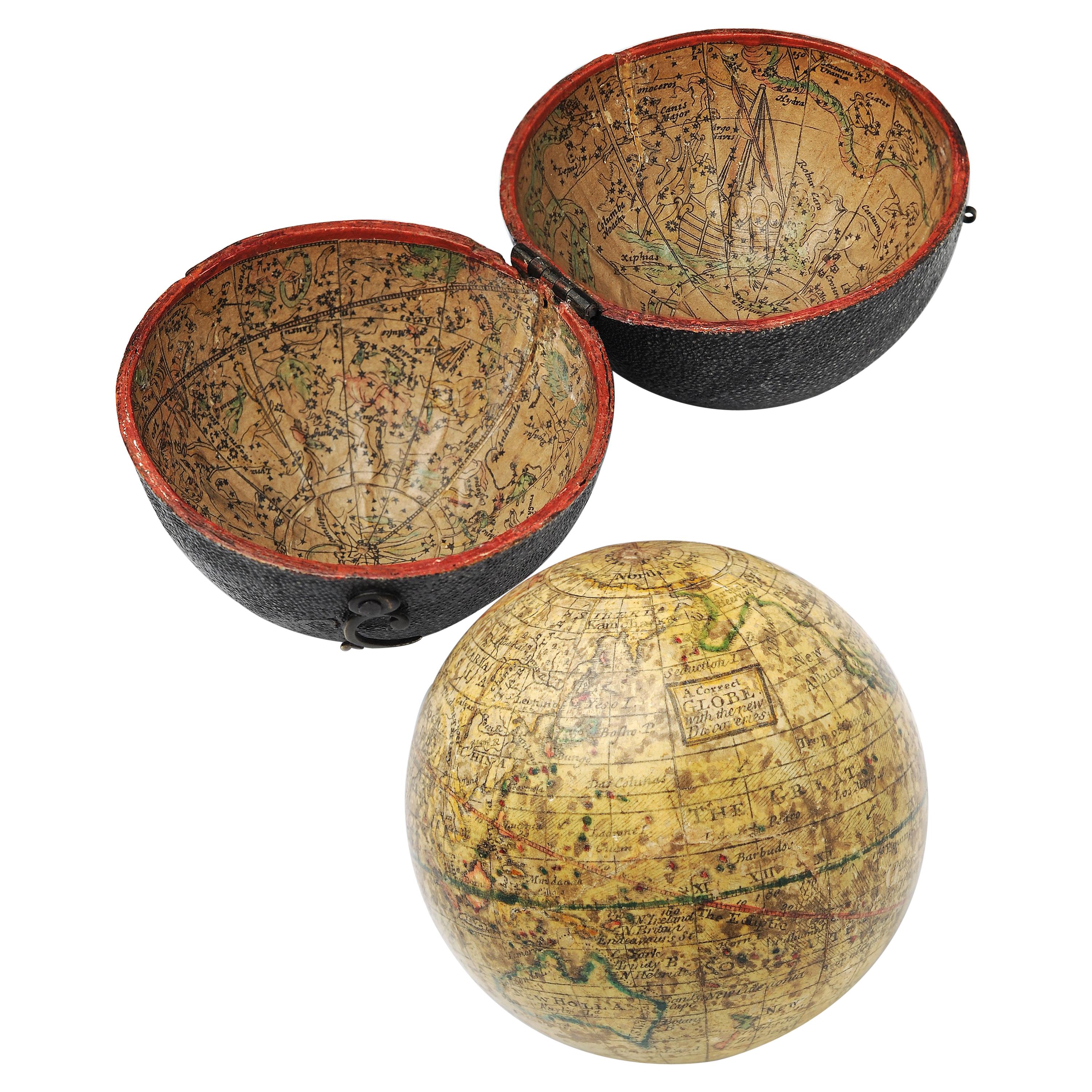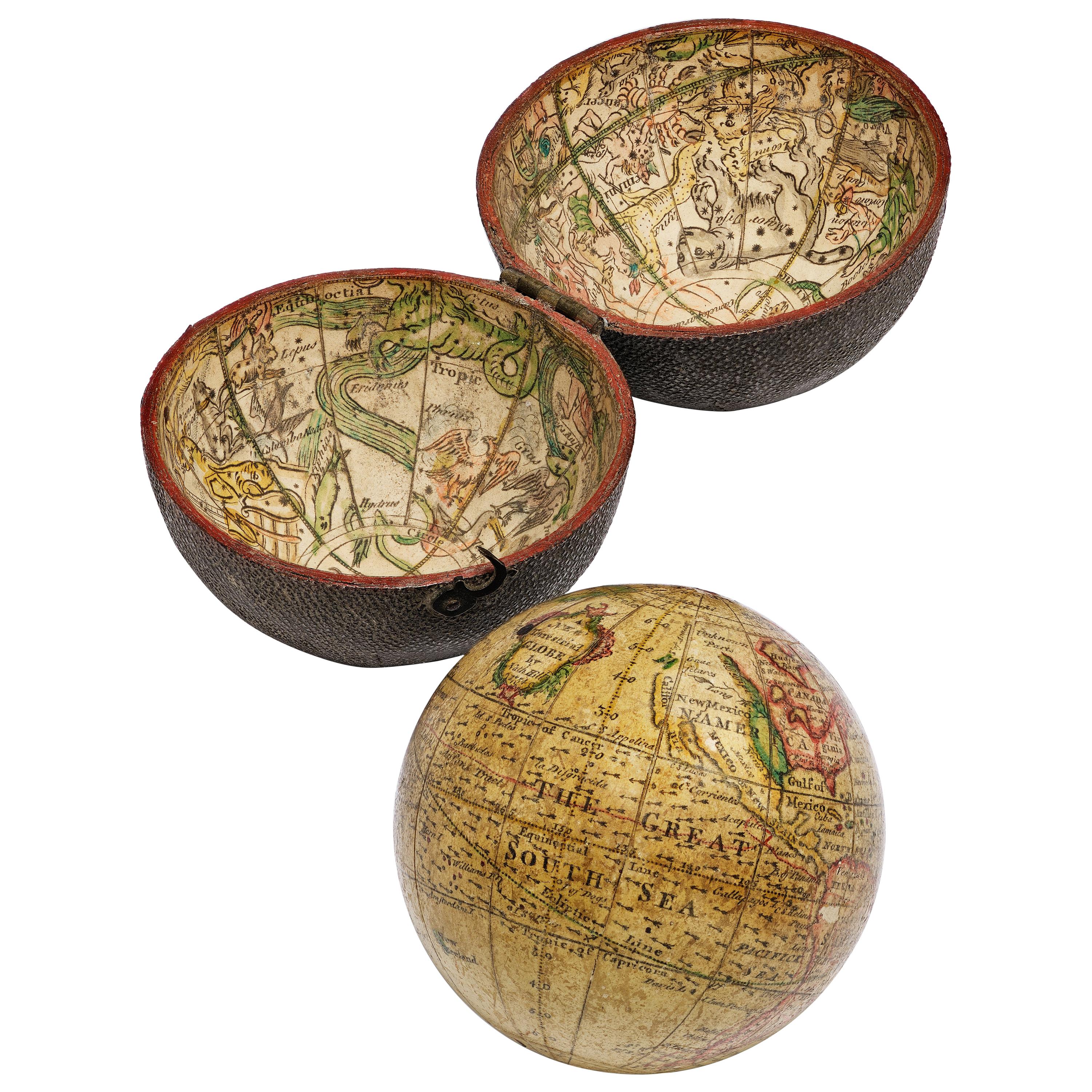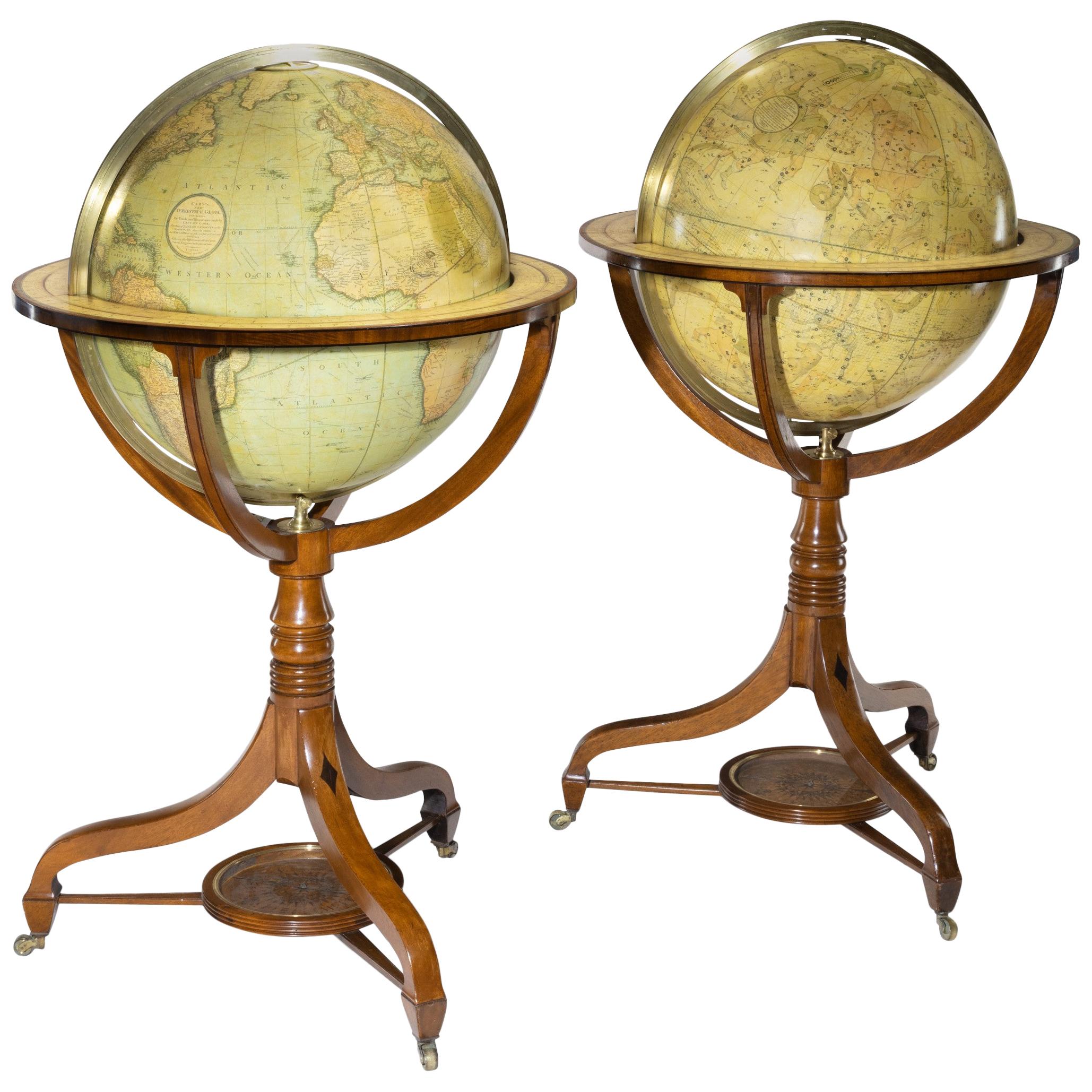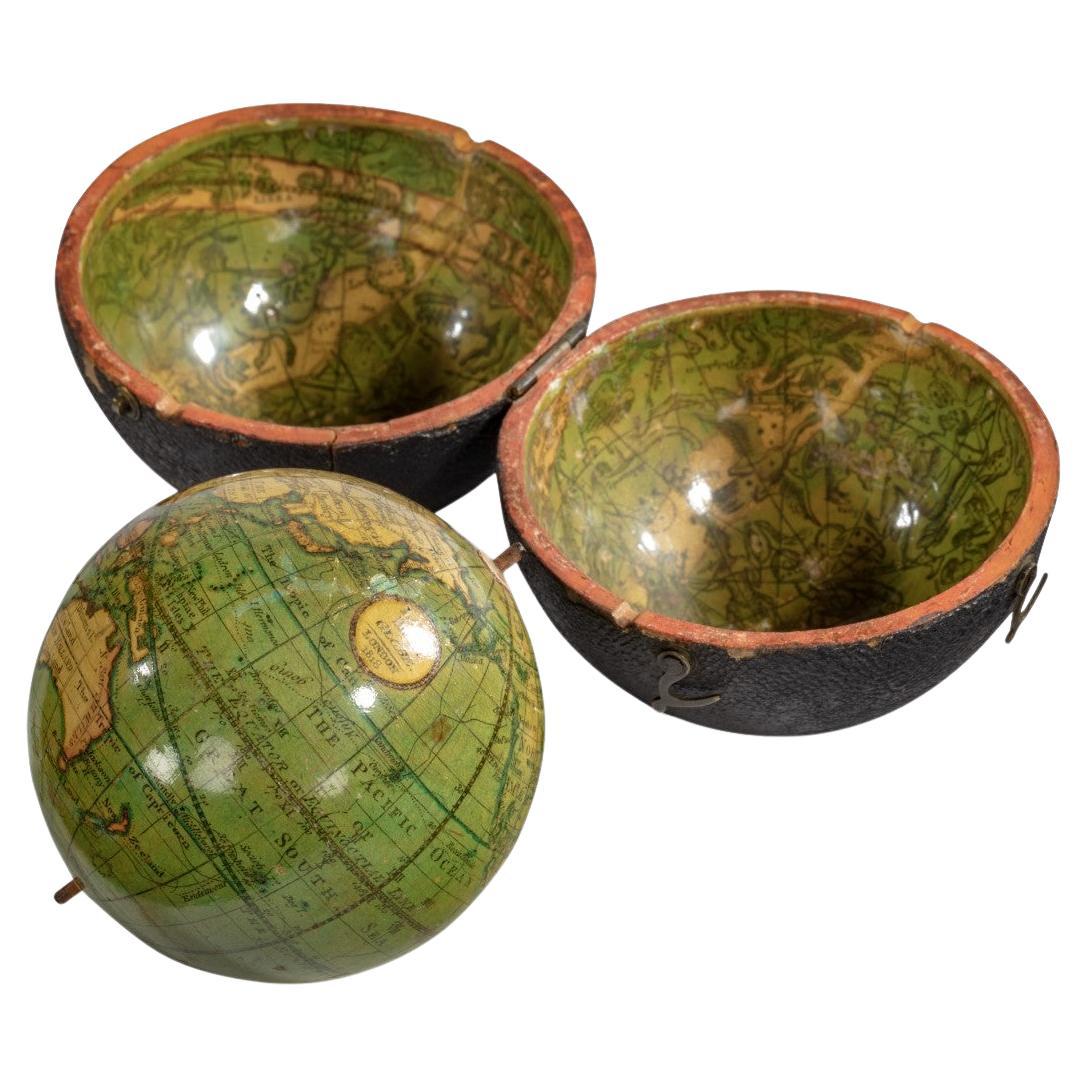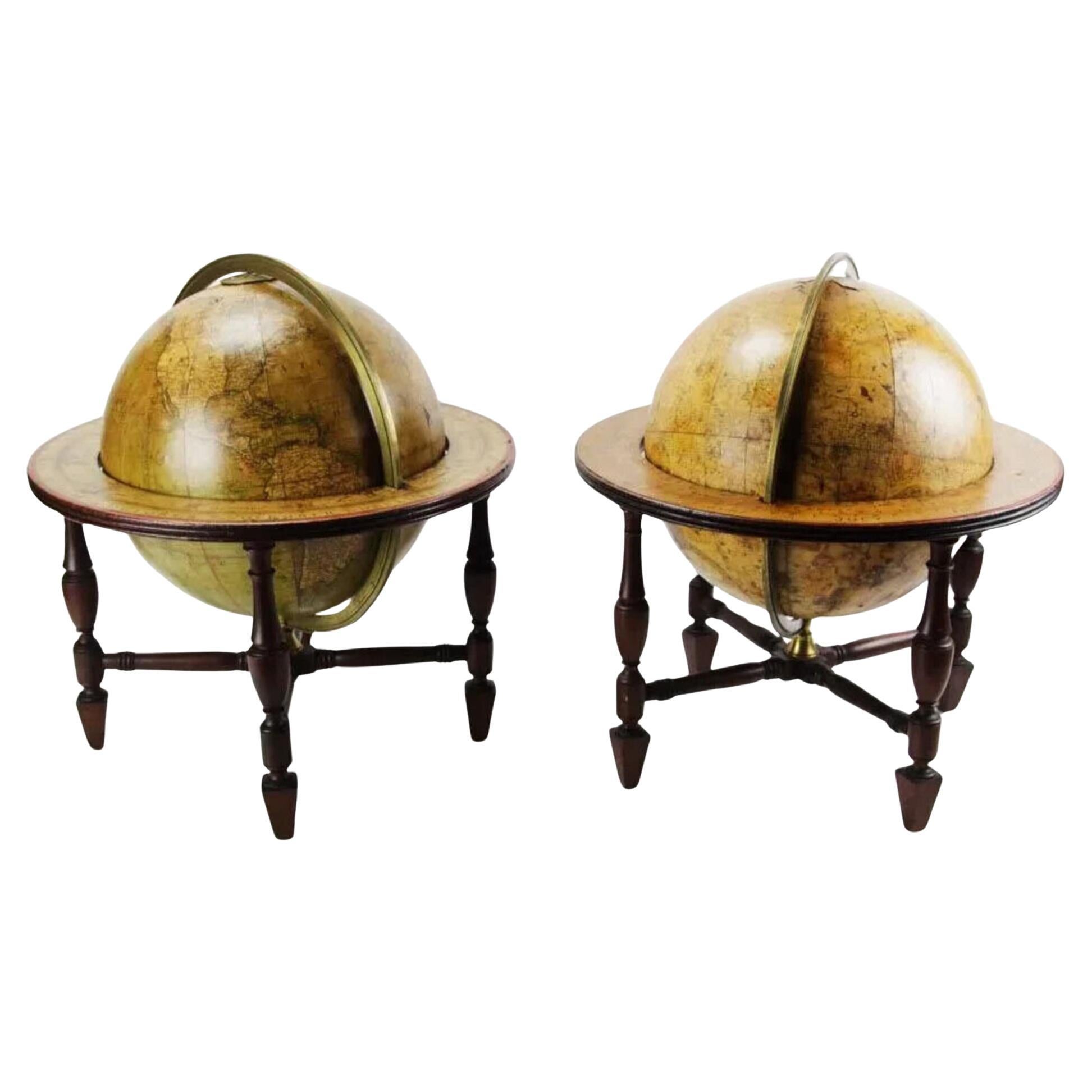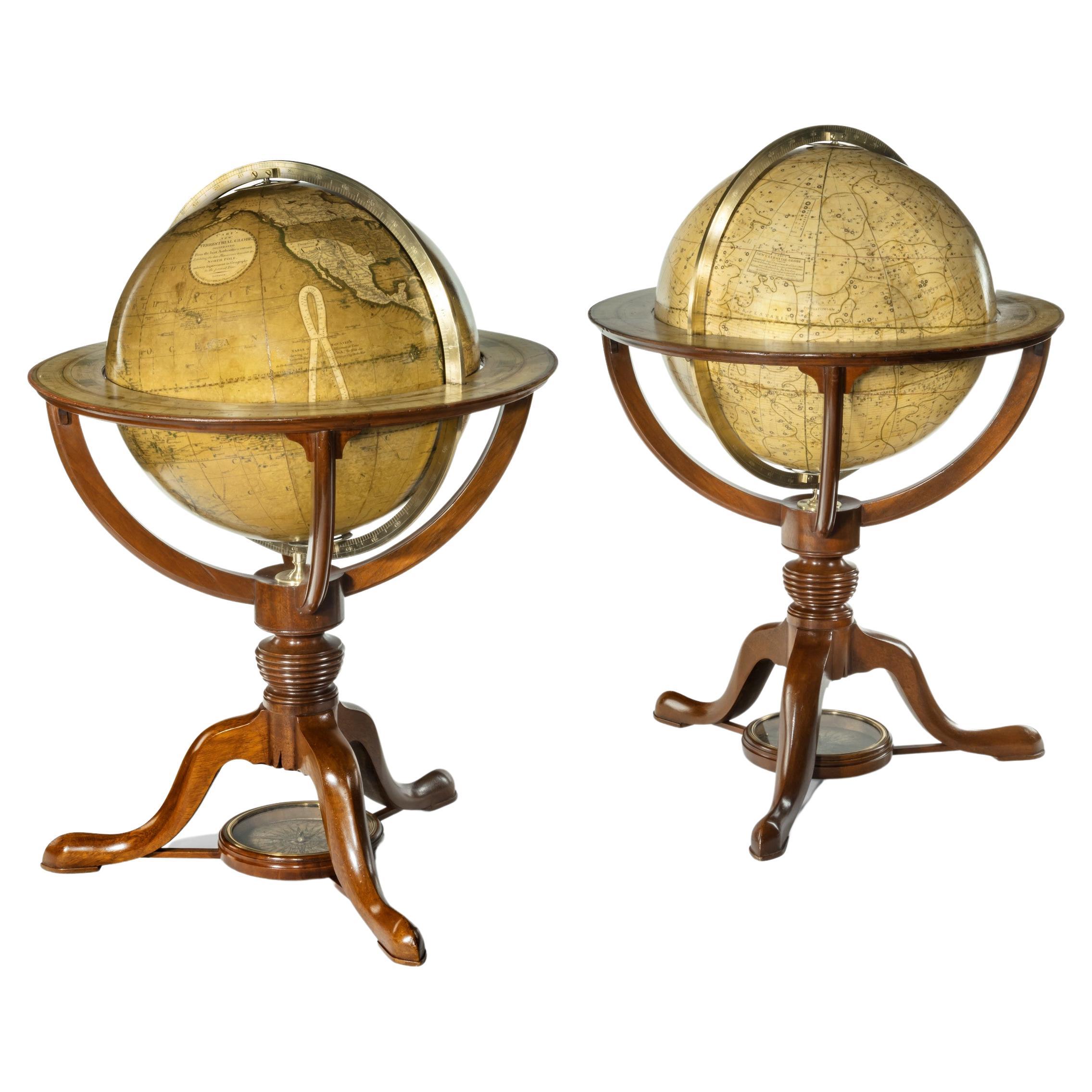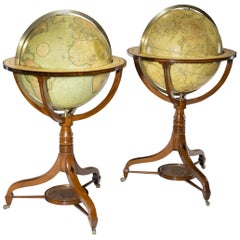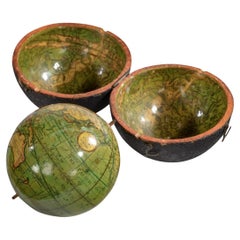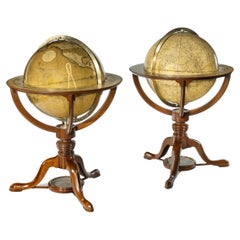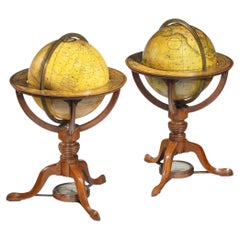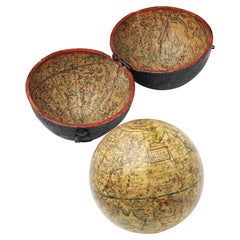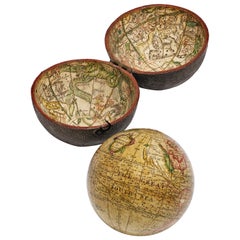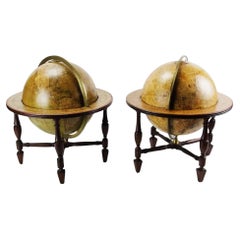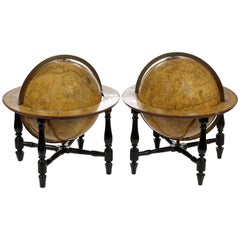Items Similar to Pair of George III 3 inch pocket globes by J & W Cary, one dated 1791
Want more images or videos?
Request additional images or videos from the seller
1 of 14
Pair of George III 3 inch pocket globes by J & W Cary, one dated 1791
$44,976.43per set
£33,000per set
€38,694.44per set
CA$62,048.90per set
A$69,000.95per set
CHF 36,240.79per set
MX$843,605.84per set
NOK 451,595.02per set
SEK 425,732.13per set
DKK 288,785.56per set
About the Item
The terrestrial globe is applied with 12 engraved and hand-coloured gores and signed in a circular cartouche ‘Cary’s Pocket Globe, Agreeable to the Latest Discoveries. Pubd. by J. & W. Cary, Strand, April 1791’. It is housed in a hinged shagreen case closed by a brass hook and lined with a hand-coloured engraved map of the ‘world as known in CÆSAR’s Time agreeable to D’Anville’ and ‘A Table of Latitudes & Longitudes of Places not given on this globe’. The celestial globe also has 12 hand-painted gores and is signed in a rectangular panel ‘New Celestial Globe by J. & W. Cary Strand’. Its hinged shagreen case (cracked) is fitted with two hooks and eyes and has a lacquered orange interior.
Diameter of globes: 3in (78 mm)
Literature: E. Dekker, Globes at Greenwich, Oxford and Greenwich, 1999, GLB0001 describes a similar globe thus “Cook’s three voyages are extensively documented. The track of Constantine Phipp’s voyage to the north (with young Horatio Nelson on board, though of course not mentioned) is labelled: Phipps 1773“.
The celebrated Cary family of cartographers and globe makers produced some of the greatest late Georgian globes. The firm was started in London in the late 18th century by John Cary (c1754-1835), an engraver and dealer in maps who often worked in partnership with his brother, William Cary (c1760-1825), a scientific instrument maker. John Cary concentrated on geographical excellence rather than on decoration. In about 1820 the Cary brothers moved their business to 86 St. James’s Street, leaving the premises at 181 Strand to John Cary’s son, George (c1788-1859) and John Jr. (1791-1852) who traded as G. & J. Cary until about 1850.
About the Seller
5.0
Recognized Seller
These prestigious sellers are industry leaders and represent the highest echelon for item quality and design.
Gold Seller
Premium sellers maintaining a 4.3+ rating and 24-hour response times
Established in 1982
1stDibs seller since 2013
133 sales on 1stDibs
Typical response time: 2 hours
Associations
LAPADA - The Association of Arts & Antiques Dealers
- ShippingRetrieving quote...Shipping from: Lymington, United Kingdom
- Return Policy
Authenticity Guarantee
In the unlikely event there’s an issue with an item’s authenticity, contact us within 1 year for a full refund. DetailsMoney-Back Guarantee
If your item is not as described, is damaged in transit, or does not arrive, contact us within 7 days for a full refund. Details24-Hour Cancellation
You have a 24-hour grace period in which to reconsider your purchase, with no questions asked.Vetted Professional Sellers
Our world-class sellers must adhere to strict standards for service and quality, maintaining the integrity of our listings.Price-Match Guarantee
If you find that a seller listed the same item for a lower price elsewhere, we’ll match it.Trusted Global Delivery
Our best-in-class carrier network provides specialized shipping options worldwide, including custom delivery.More From This Seller
View AllPair of George III Globes by J&W Cary Dated 1815 and 1800
By Cary’s
Located in Lymington, Hampshire
A pair of George III 21 inch globes by J&W Cary, dated 1815 and 1800, set in mahogany stands with turned urn-shaped supports raised on three outsplayed legs with original castors fee...
Category
Antique Early 1800s English Globes
Materials
Mahogany
Regency Lane’s Pocket Globe, Dated 1818
By Lane's
Located in Lymington, Hampshire
A 3 ½ inch Regency Lane’s pocket globe, dated 1818, the terrestrial globe with the seas in light green and the land masses outlined in darker green, contained within a hinged black shagreen case, the concave interior of the case applied with the engraved celestial charts...
Category
Antique 1810s English Regency Globes
Materials
Wood
Pair of Table Globes by G & J Cary, Dated 1800 and 1821
By George & John Cary
Located in Lymington, Hampshire
A pair of 12 inch table globes by G & J Cary, dated 1800 and 1821, each with hand-painted gores, set in mahogany stands with a turned support raised on t...
Category
Antique Early 19th Century English Globes
Materials
Mahogany
Rare Pair of Table Globes by Cary, Each Dated 1816
By John & William Cary
Located in Lymington, Hampshire
A rare pair of 9 inch table globes by Cary, each dated 1816. These globes are by John and William Cary and show the geographical and political borders drawn up following the Congress of Vienna. Each one is surmounted by a brass hour circle, within a calibrated full brass meridian, and a horizon band with an engraved paper calendar...
Category
Antique 1810s English Globes
Materials
Brass
A Fine Pair of Cary Globes, Retailed by Kirk and Mercein of New York c.1816-1820
By John Cary
Located in Lymington, Hampshire
Of American Interest-A Fine Pair of Cary Globes, Retailed by Kirk and Mercein of New York c.1816-1820
The globes of celestial and terrestrial form with their original Cary of Lond...
Category
Antique Early 19th Century English Globes
Materials
Wood
Fine Pair of Floor Globes by J & G Cary, Dated 1820 and 1833
By George & John Cary
Located in Lymington, Hampshire
A fine pair of 15 inch floor globes by J & G Cary, dated 1820 and 1833, each set into a mahogany stand with a vase shaped support and three legs centred on a compass, one with a labe...
Category
Antique Early 19th Century English Regency Globes
Materials
Mahogany
You May Also Like
English Pocket Globe, London, Circa 1775-1798
By Herman Moll
Located in Milano, IT
Pocket globe
London, between 1775 and 1798
Re-edition of the globe of Hermann Moll (1678-1732) dated 1719
The globe is contained in its original case, which itself is covered in shark skin.
There are slight gaps in the original paint on the sphere. The case no longer closes.
The sphere measures 2.7 in (7 cm) in diameter whereas the case measures 2.9 in (7.4 cm) in diameter.
lb 0.22 (kg 0.1)
The globe is made up of twelve printed paper gores aligned and glued to the sphere.
In the North Pacific Ocean there is a cartouche with the inscription:
A Correct
Globe
with the new
Discoveries.
The celestial globe is depicted on the inside of the box and is divided into two hemispheres with the cartouche:
A correct globe
with ye new cons
relations of Dr.
Halley & c.
It shows the ecliptic divided into the days of the zodiacal calendar and the constellations represented as animals and mythological figures.
On the globe are delineated the equinoctial line, divided by degrees and hours, the ecliptic and the meridian (passing west of Greenwich). The continents are shaded and outlined in pink, green and yellow. It shows: the Cook routes; a wind rose in the Southern Indian Ocean; Antarctica without land; Africa with Negroland (Hermann Moll is considered the first geographer to name the West African region in his 1727 map. (Encyclopaedia Britannica, ed. 1902, under "States of Central Africa"); Tartary in Central Asia; the Mogul kingdom in northern India; in North America only New England, Virginia, Carolina, Florida, Mississippi are identified; California is already a peninsula; the northwest coast of America is "unknown parts" (Alaska is not described and it is only partially delineated, it was to become part of the United States in 1867); Mexico is named "Spain"; Central South America "Amazone America". Australia (which was to be so named after 1829) is called New Holland. The route of Admiral Anson is traced (1740) and the trade winds are indicated by arrows. (See Van der Krogt, P., Old Globes in the Netherlands, Utrecht 1984, p. 146 and Van der Krogt, P. - Dekker, E., Globes from the Western World, London 1993, pp. 115.)
Elly Dekker, comparing Moll’s 1719 globe and his re-edition (of which the one described above is a sample), identifies the differences between them: the two editions are quite similar to each other, but in the "anonymous" globe, compared to the previous globe of 1719, California looks like a proper peninsula - the reports of the Spanish explorers of the region had given rise to uncertainty over whether it was connected to the mainland or not. The geographical nature of California was confirmed after the explorations of Juan Bautista de Anza (1774-1776). The routes of Dampier's journey were partially erased and the route of Captain James Cook's first voyage was superimposed on them, and the geography of Australasia was adapted accordingly, including the denomination of the Cook Strait. See Dekker, Elly, Globes at Greenwich, 1999.
An important ante quem element is represented by Tasmania: it is not separated from Australia by the Bass Strait...
Category
Antique Late 18th Century English George III Globes
Materials
Shagreen, Paper
Pocket Globe by Nathaniel Hill, London 1754
Located in Milano, IT
Nathaniel Hill
Pocket globe
London, 1754
The globe is contained in its original case, which itself is covered in shark skin.
There are slight gaps in the original paint on the sphere. The case no longer closes.
The sphere measures 2.6 in (6.8 cm) in diameter whereas the case measures 2.9 in (7.4 cm) in diameter.
lb 0.24 (kg 0.11)
The globe is made up of twelve printed paper gores aligned and glued to the sphere.
In the North Pacific Ocean there is a scroll with the inscription:
A
New
terrestrial
Globe
by
Nath. Hill,
1754.
The celestial globe is depicted on the inside of the box.
On the terrestrial globe much of central and southern Africa is empty. North America bears only the name of some British colonies. It shows California as a peninsula and the northwest coast of America as "unknown parts" (Alaska is not described and is only partially delineated; it would become part of the United States in 1867). The route of Admiral Anson is traced (1740) and the trade winds are indicated by arrows. Australia, still named New Holland (the new name would be introduced in 1829), is part of the west coast. (See Van der Krogt, P., Old Globes in the Netherlands, Utrecht 1984, p. 146 and Van der Krogt, P. - Dekker, E., Globes from the Western World, London 1993, p. 115.)
Nathaniel Hill (London, news from 1746 to 1768) had impeccable professional credentials: he had done his apprenticeship with Richard Cushee, who at the time was carrying out surveying work for John Senex's Surrey map...
Category
Antique 1750s English George II Globes
Materials
Shagreen, Paper
Early 1800's Antique British, 12-Inch, Terrestrial Celestial Globes, Set of Two
Located in Austin, TX
Handsome Pair of Early 1800's Antique British, 12-Inch, Terrestrial Celestial Globes, Set of Two!!
Very Handsome Pair of Antique Celestial Globes...
Category
Antique Early 19th Century British Other Globes
Materials
Wood
Pair of Fine Desk Globes by J. Cary, 1816 and 1824
Located in Amsterdam, NL
A pair of desk globes by J. Cary
“Cary’s New Terrestrial Globe delineated from the best Authorities extant; exhibiting the late discoveries toward the North Pole and every improve...
Category
Antique Early 19th Century Maps
Materials
Other
Pair of English 12-inch Globes by William Harris, London, 1832 and 1835
By William Harris
Located in Milano, IT
Pair of 12-inch table globes
William Harris
London, 1832 and 1835
Slight abrasions from use; few cracks
lb 11 each (kg 5)
The two terrestrial and celestial globes rest in their original Dutch style stands with four supporting turned wood columns.
Each one measures 12 in in height x 16.5 in in diameter with the diameter of the spheres measuring approximately 12 in; 48 cm in height x 42 cm in diameter x 31 cm diameter of the spheres.
The 12 inch measure was the most frequently used by British manufacturers of globes of this period.
Each globe is composed of two series of twelve printed paper gores, aligned and glued onto plaster spheres.
The brass circle of the meridian bears engravings...
Category
Antique 1830s English William IV Globes
Materials
Paper, Wood
Pair of Early 19th Century English Cary Terrestrial/Celestial Table Model Globes
By George & John Cary, John & William Cary
Located in Milford, NH
A fine pair of 12-inch English table model globes on stands, manufactured by G.& J. Cary, the left globe with cartouche labeled “Carey’s New Terrestrial Globe, delineated from the be...
Category
Antique Early 19th Century English Globes
Materials
Brass
